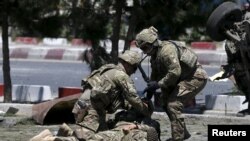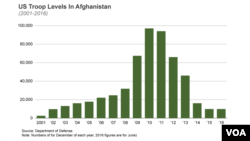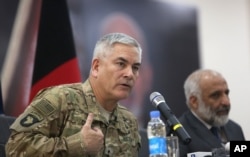Three former U.S. envoys to Afghanistan called on the Obama administration this week not to cut U.S. troop levels in that country next year, even as the White House indicated that it remains committed to doing just that.
Dan Feldman, James Dobbins and Marc Grossman all served as U.S. special representatives to Afghanistan and Pakistan between 2011 and 2015 and remain influential voices in Washington foreign policy circles. Along with 10 other former senior diplomats and military commanders who served in Afghanistan, they sent an open letter to President Barack Obama this month, urging him to drop plans to halve the number of American troops in Afghanistan.
Currently there are 9,800 American troops serving on Afghanistan, but their number is due to be reduced to 5,500 in 2017.
“I think it’s an important signal – for the Afghan people, the Afghan government and its international partners – that the U.S. will continue to keep its commitment to this number of troops (9,800) through the end of this administration," Feldman said. This would allow whoever takes over from Obama in January "to make a decision very soon," he added.
The White House has given no indication that the president intends to change his mind on the troop drawdown schedule, but has said he remains open to possible "adjustments" recommended by military commanders and his advisers.
Feldman, now a partner in a Washington law firm, and others say the president should make clear now that the U.S. force reduction schedule will be set aside, so American troops can bolster Afghan security forces struggling against a reinvigorated Taliban insurgency.
Grossman, a former undersecretary of state, said Afghans would see reduced U.S. troop levels as a sign of diminishing support from Washington, and that would send the “wrong signal” to Pakistan and the broader region.
“We felt that in all of those cases – the broader Middle East, Afghanistan and Pakistan – leaving troop levels as they were was the best course,” said Grossman, now a vice chairman at a Washington consulting and lobbying firm.
Dobbins, a former diplomat who was instrumental in creating the post-Taliban government in Afghanistan, said the current force level is the "minimum necessary to continue to support and assist and sustain the Afghan national security forces and to hold the Taliban at bay.”
The post of U.S. special representative to Afghanistan and Pakistan, known as SRAP, was established in 2009, in the early days of Obama's first term, to coordinate U.S. strategy in the region while American forces were driving a military and civilian surge against the Taliban.
In identical, nearly simultaneous statements this week, two senior U.S. officials – Richard Olson, the current SRAP, and the deputy U.S. envoy to the United Nations, Michele Sison – repeated the administration’s commitment to the drawdown timetable announced in October. Feldman said those messages, delivered to the Atlantic Council and the U.N. Security Council, suggest the administration is sticking to its plans.
The White House has said just as much, but there has been no talk of possible "adjustments" it might make following a security assessment completed this month by General John Nicholson, three months after he took over as the top U.S. military commander in Afghanistan.
Despite his famously fraught relationship with the military, President Obama has shown greater openness to proposals by his top generals in Afghanistan in recent years, as defeating an increasingly dogged Taliban insurgency has proved elusive.
The troop drawdown plan of October 2015, in fact, was a reversal of another, earlier plan to reduce the level of U.S. forces even more sharply. Acting on a request by Nicholson's predecessor, General John Campbell, Obama said the U.S. would keep 9,800 troops in Afghanistan through most of this year. And just this month, the president gave Nicholson authorization to order airstrikes against Taliban targets and to allow American troops to accompany patrols by Afghan security forces – moves welcomed by the embattled Kabul government.
Briefing reporters on June 10, White House spokesman Josh Earnest said that authorization to Nicholson "does not limit in any way our ability to follow through with the plan to draw down troops [to] the level of 5,500."
Few details of Nicholson's report have been revealed. If there are further recommendations about troop reductions in Nicholson’s security assessment, a U.S. defense official who asked not to be identified said the military is “seeing how the new authorizations go first.
Feldman, who noted it would be highly unusual for a commander involved in an increasingly bloody, still active conflict to suggest troop cuts, said any further decision altering the timing and size of the U.S. drawdown would take at least weeks, if not months.
A bipartisan group of 10 members of the U.S. Senate Armed Services Committee asked Obama in May to clarify his position on troop levels ahead of a NATO summit in Warsaw in July. They asked that he give Nicholson’s recommendations “extraordinary weight.”
“I think that as long as the struggle with the Taliban continues to be as challenging as it is, and the potential threat from [the Islamic State group] expanding into Afghanistan, it is important for the U.S. to continue to have a presence in Afghanistan,” Democratic Senator Jeanne Shaheen said in an interview.
“I think we could be up or down a little bit on that number, but they’re there ... on the ground,” Shaheen said of U.S. troops. “It’s important not to reduce it any further, unless circumstances change.”










